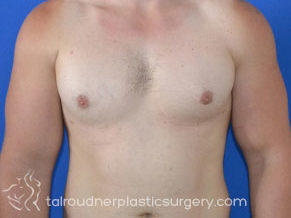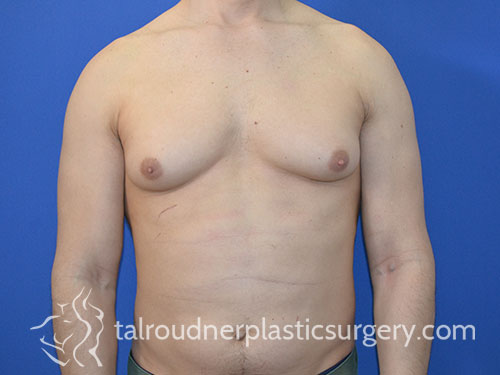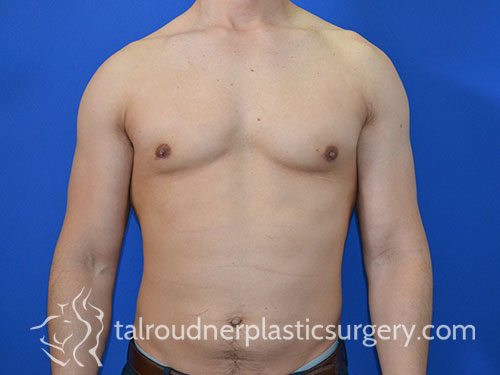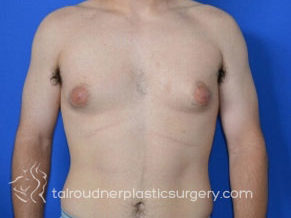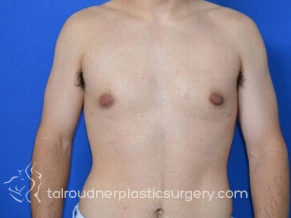Gynecomastia or male breast reduction, is a common breast condition in men in which the estrogen levels are too high and excess breast tissue grows, causing a feminine appearance in the chest (sometimes called “man boobs”).1 Many think of estrogen as a female hormone, however, men also produce it in small quantities. Estrogen is important for both men and women, as it plays a role in bone health, brain function, and regulating cholesterol levels.
While several medical conditions and medications can cause gynecomastia, the condition typically occurs in men during puberty as a result of hormonal changes and resolves naturally over a period of a year. However, in some men the condition persists into, or appears during adulthood as testosterone levels drop. Men with gynecomastia are often otherwise lean and fit, however, male breast growth from gynecomastia can easily be distinguished from enlarged pectoralis muscles caused by exercise.
In addition to overdeveloped breasts, an enlargement of the nipple areolar complex (NAC), also known as “puffy nipples”, is one of the most common presenting features of gynecomastia. The true glandular breast tissue hypertrophy is usually concentrated under the nipple areolar complex forming a dome shaped NAC, but at times may protrude outside the NAC forming a dome shape under the NAC with a tail towards the lateral chest.
- Breast Reduction Surgery For Men (Gynecomastia Treatment)
- Male Breast Reduction Surgery at Our Miami Office
- Am I A Candidate For Male Breast Reduction Surgery?
- Your Consultation For Male Breast Reduction
- Before Your Male Breast Reduction Surgery
- Treatment Options for Male Breast Reduction (Gynecomastia) Surgery
- What to Expect: Recovery & Results of Male Breast Reduction
- Schedule A Consultation for Male Breast Reduction Surgery
- FAQs About Gynecomastia Surgery
Breast Reduction Surgery for Men (Gynecomastia Treatment)

Gynecomastia is typically non-cancerous but rarely it could become breast cancer. In general gynecomastia does not cause any physical pain, but can be sensitive to touch and often causes psychological distress and low self-esteem.2 Breast reduction surgery can restore confidence and create a more masculine physique. Dr. Tal Roudner understands that men with male breast enlargement often feel upset and embarrassed by the condition, and he will work with you to help you become more comfortable in your own skin.
Tal T. Roudner, M.D., F.A.C.S. is a board-certified Miami plastic surgeon highly experienced in treating gynecomastia, the condition that causes enlarged male breasts. Dr. Tal Roudner’s surgical goal for male breast reduction is to remove the excess glandular and soft fatty breast tissue and contour the chest to a natural-looking masculine appearance while minimizing visible scars.
Male Breast Reduction Surgery at our Miami Office
If you are considering male breast reduction, also known as gynecomastia surgery or reduction mammaplasty, it is important to choose a surgeon who is experienced in treating gynecomastia. Dr. Tal Roudner has in-depth knowledge of this particular condition and is highly skilled in the surgical treatment of gynecomastia. He is known for his compassionate care and surgical precision.
This surgery is typically performed under general anesthesia. Dr. Tal Roudner may perform a series of different procedures while reducing the breast tissue such as direct glandular excision (reduction mammaplasty/mastectomy), suction-assisted lipectomy (SAL), ultrasonic-assisted lipectomy (UAL), removing and repositioning the skin and soft tissue (transposition flaps), as well as repositioning the areola and nipple, or a combination of these surgical techniques.
Am I A Candidate for Male Breast Reduction Surgery?
If you think you may have gynecomastia, or if you have been diagnosed by your healthcare provider and are considering surgery, you are not alone. According to the American Society of Plastic Surgeons, over 18,500 American men chose surgery to treat gynecomastia in 2020.3 You may be a candidate for this surgery if you:
- Are in general good health
- Have gynecomastia due to hormonal imbalance or use of certain medications
- Have enlarged breasts due to excess glandular tissue
- Are experiencing excess breast tissue after weight loss
- Have found that medications such as Tamoxifen have not entirely eliminated excess breast tissue
Your Consultation for Male Breast Reduction
The first step to determining if surgical treatment for gynecomastia is right for you is to schedule a consultation with Dr. Tal Roudner at our Miami office. At this initial appointment, Dr. Tal Roudner will perform an examination, discuss your current health as well as your medical history, and review the medications you are currently taking and have taken in the past. Because male breast enlargement is often caused by hormonal imbalance, blood work may also be ordered for a hormonal workup. A testicular exam at times may be performed as well to rule out testicular cancer as the cause of the breast enlargement. Dr. Roudner will also take photos to include in your patient file.
During your consultation, it is important to be open about your medical history as well as your goals for surgery. The consultation will include a detailed discussion regarding the risks, benefits, and complications associated with the breast reduction procedure and Dr. Tal Roudner will answer any questions regarding the procedure. The highlights of the pre and post-operative instructions will be reviewed to ensure proper preparation prior to the procedure and a safe and speedy post-operative recovery.
Before Your Male Breast Reduction Surgery
Once you have decided that surgical treatment for gynecomastia is right for you, your surgery and pre-operative appointments will be scheduled at our Miami office. It is critical that you attend all appointments and follow all instructions. Your pre-operative appointment will be scheduled approximately two weeks before your surgery and you will be given detailed instructions. Please read and adhere to all pre-surgical protocols and call us with any questions. General guidelines include:
- If you smoke, you need to stop 4 weeks prior to surgery. If you need assistance quitting, please let our office know.
- Cease using anabolic steroids or marijuana prior to your pre-op appointment
- Make arrangements for a friend or family member to transport you to and from surgery and stay with you during the first 24 hours of recovery
- Eat a healthy diet and avoid alcohol the week before surgery
- Do not perform any strenuous activity the day before surgery
- Do not eat or drink anything, including water, after midnight before surgery
- Shower or bathe the evening before surgery and do not use any lotions, fragrances or deodorant the night before or day of surgery
Treatment Options for Male Breast Reduction (Gynecomastia) Surgery
There are many techniques used in male breast reduction surgery. The goal of all techniques is to reduce the breast size, flatten the chest and enhance the chest shape and contour.
Liposuction
In minor cases of male breast enlargement due to excess fatty tissue without enlargement of the glandular breast tissue, also known as pseudogynecomastia, use of suction-assisted lipectomy (liposuction) may be sufficient to treat the condition.
Direct Excision – Partial Mastectomy
If glandular breast tissue enlargement is present a partial mastectomy (removal of glandular breast tissue) using a periareolar incision may be needed to remove the fibrous breast tissue. Other methods include using Ultrasonic liposuction in combination with other suction-assisted devices but in general, direct excision achieves the best results when dealing with glandular breast tissue.
Moderate cases where both glandular and fatty tissues are present require a combination of direct excision (partial mastectomy) as well as feathering suction-assisted lipectomy (liposuction).
Liposuction – Direct Glandular Excision – Skin Excision
In severe cases of gynecomastia, in addition to the excess of glandular breast tissue as well as excess fatty tissue, there is excess sagging skin as well as possible enlargement of the nipple-areolar complex. These cases require excision of the excess sagging skin, reduction, and repositioning of the nipple-areolar complex as well as the removal of the breast glandular tissue and fatty tissues as described above. In these cases scarring can be extensive and should be taken into consideration prior to surgery.
What to Expect – Recovery and Results of Male Breast Reduction
Patients should take a week off of work and expect to rest that entire time. At 4 weeks patients may make a gradual return to mild to moderate exercise and at 6 weeks can usually fully resume normal activity. After surgery, dressings or bandages will be applied to the incisions, as well as a support garment to help minimize swelling, improve skin retraction, and help contour the chest. If drains are placed they will be removed once the drainage output is less than 30cc over a 24 hour period (most commonly 3 to 7 days). You will be given detailed post-op instructions, and it is important to follow them and call Dr. Tal Roudner right away with any concerns.
While it may take a few weeks for initial recovery and six weeks to return to full normal activity, it takes six months to a year for the swelling to subside, the skin to contract, and for the chest to shape into the final results.
Schedule a Consultation For Male Breast Reduction Surgery
If you have refrained from activities due to embarrassment, or if you have experienced a lack of confidence because of gynecomastia, we may be able to help. Dr. Tal Roudner and his staff are compassionate, discreet, and experienced in surgical treatment for gynecomastia. Contact us today to schedule a consultation for male breast reduction surgery.
FAQs About Gynecomastia
What Causes Gynecomastia?
Common causes of gynecomastia include hormonal shifts that create a high estrogen to androgen ratio, as well as conditions that lead to low testosterone production such as hypogonadism. The condition can be a side effect of certain medications such as anti-androgens used to treat prostate cancer, ulcer medications such as cimetidine, we well as antibiotics, tricyclic antidepressants, anti-anxiety medications like diazepam, certain inhibitors, spironolactone, and even illegal drugs including anabolic steroids, marijuana, and amphetamines. Gynecomastia can also be caused by genetic predisposition, and medical conditions including thyroid disorders such as hyperthyroidism, or less commonly by testicular cancer, tumors involving the testes, adrenal or pituitary gland, as well as changes in hormone levels related to cirrhosis, liver disease, kidney disease, and kidney failure, but in most cases the cause of gynecomastia is idiopathic (unknown).
Although extremely rare male breast cancer should be considered in the differential diagnosis of older men with a sudden enlargement of their breast tissue. This can be ruled out with a mammogram/ultrasound and/or biopsy to check the tissue for cancerous cells. True gynecomastia is the enlargement of breast glandular tissue which is firm. Breast growth caused by excess fat or obesity, without hypertrophic breast tissue, is called pseudogynecomastia.
How Do I Know If I Have Gynecomastia
Gynecomastia is diagnosed with a review of your family history, a physical examination, a blood test to check hormone levels, and possibly a mammogram or ultrasound to see detailed images of breast tissue.
How Common is Gynecomastia?
The prevalence of gynecomastia is approximately 50-60% in adolescent boys, and 65% in men aged 27 to 92 years of age.5
Is Male Breast Reduction Surgery
Most patients experience mild to moderate pain and discomfort in the first 3 days to a week, for which pain medication may be prescribed. As healing progresses and you become more active, you may experience some pain if you overexert yourself, at which time you should stop the activity and rest. By six weeks after surgery, any discomfort should be minimal.
1 Indian Journal of Endocrinology and Metabolism. Gynecomastia: Clinical evaluation and management. Available: https://www.ncbi.nlm.nih.gov/pmc/articles/PMC3987263/. Accessed February 2, 2022.
2 ASPS. Gynecomastia Has Psychological Impact on Adolescent Boys. Available: https://www.plasticsurgery.org/news/press-releases/gynecomastia-has-psychological-impact-on-adolescent-boys. Accessed February 2, 2022.
3 ASPS. 2020 Plastic Surgery Statistics Report. Available: https://www.plasticsurgery.org/documents/News/Statistics/2020/plastic-surgery-statistics-full-report-2020.pdf. Accessed February 3, 2022.
4 Cleveland Clinic. Enlarged Male Breast Tissue (Gynecomastia). Available: https://my.clevelandclinic.org/health/diseases/16227-enlarged-male-breast-tissue-gynecomastia. Accessed February 2, 2022.
5 ASPS. How does gynecomastia affect boys and men at different ages? Available: https://www.plasticsurgery.org/news/blog/how-does-gynecomastia-affect-boys-and-men-at-different-ages. Accessed February 2, 2022.







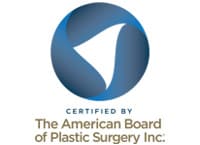



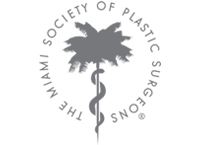
Request a Consultation
Call 305-767-7719 or Use the Form Below to Schedule Online!
Dr. Tal Roudner has either authored or reviewed and approved the content on this website.
Page Updated:


